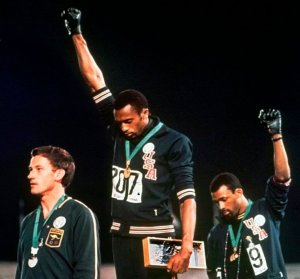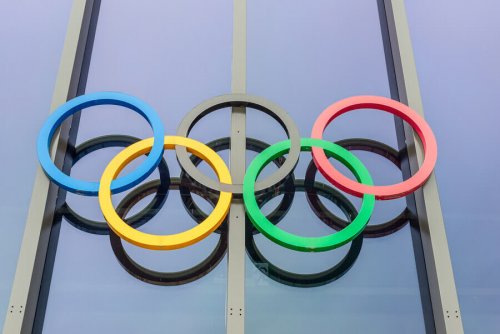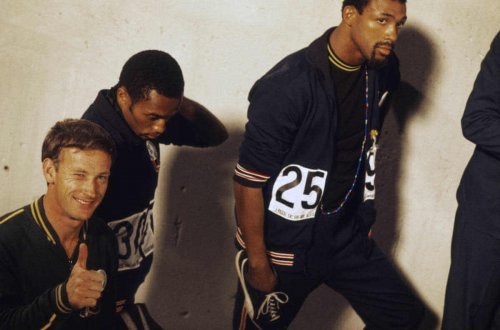The Black Power Salute of the 1968 Olympics

All editions of the Olympic Games have something remarkable or unique. However, the black power salute that took place in Mexico in 1968 will be remembered forever. What was it about? We’ll tell you in this article.
The Mexico 1968 Olympic Games and its controversies
Before talking about the black power salute, it’s worth highlighting other issues of the 1968 Olympic Games in Mexico. First of all, it was difficult to choose the venue, due to the height of Mexico City, which is more than two thousand meters above sea level.
In addition, they didn’t allow South Africa to participate since they were threatening to boycott the Games. Prior to that, the International Olympic Committee had urged them to include athletes of all ethnicities in the participating team, but apartheid policies prohibited it.
As if all this weren’t enough, in Mexico, there was an intricate atmosphere due to the local student movement. This group of young people sought the revolution and wanted to unmask the government during the games; another boycott attempt that was decimated on time.
The black power salute
After overcoming several obstacles, Mexico went on to inaugurate the Summer Olympics on October 12, 1968. Four days later, everyone would witness a peaceful protest that no one will ever forget.
Everything took place in track and field, more precisely at the end of the 200-meter race. World records were broken in the competition, but that’s not what people remember.
At the time of the podium, the winners of the gold and bronze medals – Tommie Smith and John Carlos, respectively, the silver medal went to the Australian Peter Norman – made a sign of protest for black civil rights in the United States.
Both athletes were of African-American origin and, while playing the American national anthem – since they were the gold-winning country – they lowered their heads, closed their eyes, and raised their fists, which were wrapped in black gloves; representing the poverty of their race.

Besides that, Smith had a black scarf on his neck, representing pride in his ethnicity. Meanwhile, Carlos had an unbuttoned tracksuit on in solidarity with the workers of his country and a bead necklace. In his own words: “It was for the people killed, lynched, or hanged who didn’t receive a prayer.”
Even the Australian silver medalist expressed sympathy for the movement and was the one who suggested the American athletes share Smith’s pair of black gloves; Carlos had forgotten his own in the dressing room.
The image of this black power salute was the cover of every newspaper in the world the day after the competition. However, prior to this, the spectators present dismissed the athletes with boos.
Smith made a subsequent statement explaining his motives: “If I win, I am an American, not a black American. But if I do something bad, then they would say “a Negro”. We are black and we are proud of being black. Black America will understand what we did tonight”.
The repercussions of the black power salute
Of course, the international media weren’t the only ones echoing the event in those Games. On one hand, the then president of the International Olympic Committee, Avery Brundage, considered the gesture as unacceptable in the field fo the Games and the Olympic spirit.
While he did ask the organizers to expel Smith and Carlos from the Olympics, they didn’t accept and gave consent to a”guest of honor” status to the America athletes.

On the other hand, both athletes were criticized in their country and sentenced to ostracism. They even received death threats. However, this didn’t stop them: they would continue with their athletic careers and after retiring, they went on to play American football.
Finally, we also have to talk about the Australian Norman, who went on to receive admonishment by the Olympic authorities upon returning to his country. Marginalized by local media and not elected to the 1972 Munich Games. After an injury and amputation of his right leg, he fell into depression and alcoholism. When he died of a heart attack, Smith and Carlos carried the coffin at his funeral.
All editions of the Olympic Games have something remarkable or unique. However, the black power salute that took place in Mexico in 1968 will be remembered forever. What was it about? We’ll tell you in this article.
The Mexico 1968 Olympic Games and its controversies
Before talking about the black power salute, it’s worth highlighting other issues of the 1968 Olympic Games in Mexico. First of all, it was difficult to choose the venue, due to the height of Mexico City, which is more than two thousand meters above sea level.
In addition, they didn’t allow South Africa to participate since they were threatening to boycott the Games. Prior to that, the International Olympic Committee had urged them to include athletes of all ethnicities in the participating team, but apartheid policies prohibited it.
As if all this weren’t enough, in Mexico, there was an intricate atmosphere due to the local student movement. This group of young people sought the revolution and wanted to unmask the government during the games; another boycott attempt that was decimated on time.
The black power salute
After overcoming several obstacles, Mexico went on to inaugurate the Summer Olympics on October 12, 1968. Four days later, everyone would witness a peaceful protest that no one will ever forget.
Everything took place in track and field, more precisely at the end of the 200-meter race. World records were broken in the competition, but that’s not what people remember.
At the time of the podium, the winners of the gold and bronze medals – Tommie Smith and John Carlos, respectively, the silver medal went to the Australian Peter Norman – made a sign of protest for black civil rights in the United States.
Both athletes were of African-American origin and, while playing the American national anthem – since they were the gold-winning country – they lowered their heads, closed their eyes, and raised their fists, which were wrapped in black gloves; representing the poverty of their race.

Besides that, Smith had a black scarf on his neck, representing pride in his ethnicity. Meanwhile, Carlos had an unbuttoned tracksuit on in solidarity with the workers of his country and a bead necklace. In his own words: “It was for the people killed, lynched, or hanged who didn’t receive a prayer.”
Even the Australian silver medalist expressed sympathy for the movement and was the one who suggested the American athletes share Smith’s pair of black gloves; Carlos had forgotten his own in the dressing room.
The image of this black power salute was the cover of every newspaper in the world the day after the competition. However, prior to this, the spectators present dismissed the athletes with boos.
Smith made a subsequent statement explaining his motives: “If I win, I am an American, not a black American. But if I do something bad, then they would say “a Negro”. We are black and we are proud of being black. Black America will understand what we did tonight”.
The repercussions of the black power salute
Of course, the international media weren’t the only ones echoing the event in those Games. On one hand, the then president of the International Olympic Committee, Avery Brundage, considered the gesture as unacceptable in the field fo the Games and the Olympic spirit.
While he did ask the organizers to expel Smith and Carlos from the Olympics, they didn’t accept and gave consent to a”guest of honor” status to the America athletes.

On the other hand, both athletes were criticized in their country and sentenced to ostracism. They even received death threats. However, this didn’t stop them: they would continue with their athletic careers and after retiring, they went on to play American football.
Finally, we also have to talk about the Australian Norman, who went on to receive admonishment by the Olympic authorities upon returning to his country. Marginalized by local media and not elected to the 1972 Munich Games. After an injury and amputation of his right leg, he fell into depression and alcoholism. When he died of a heart attack, Smith and Carlos carried the coffin at his funeral.
All cited sources were thoroughly reviewed by our team to ensure their quality, reliability, currency, and validity. The bibliography of this article was considered reliable and of academic or scientific accuracy.
- Smith, M. M. (2011). The “revolt of the black athlete”: Tommie Smith and John Carlos’s 1968 black power salute reconsidered. In Myths and Milestones in the History of Sport. https://doi.org/10.1057/9780230320819
This text is provided for informational purposes only and does not replace consultation with a professional. If in doubt, consult your specialist.








